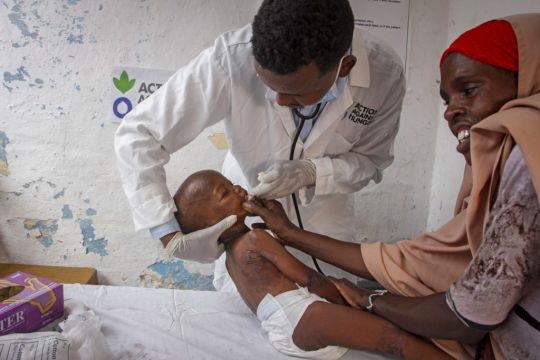The worst drought in the Horn of Africa in four decades has sparked efforts to prevent famine, with hundreds of people having died of malnutrition already in the region.
Previously unreported data shared with the Associated Press show at least 448 deaths this year at malnutrition treatment centres in Somalia alone.
Authorities in Somalia, Ethiopia and Kenya are now shifting to the grim task of trying to prevent famine, with many more people feared to be dying beyond the notice of authorities.
"An explosion of deaths is about to happen in the Horn of Africa."
UNICEF's @RaniabtBakhita on the severity of the drought in the region and its impact on children's lives.— UNICEF (@UNICEF) June 7, 2022
Advertisement
One woman from Somalia, Owliyo Hassan Salaad, has watched four of her children die this year, all younger than 10.
Some die in remote pastoral communities. Some die on treks in search of help. Some die even after reaching displacement camps, malnourished beyond aid.
UN humanitarian coordinator for Somalia, Adam Abdelmoula, told reporters that “definitely thousands” have died.

Ms Salaad left behind another four children with her husband to travel to a malnutrition stabilisation centre in Mogadishu with her three-year-old child Ali Osman. They were too weak to make the journey to the capital, she said.
Drought comes and goes in the Horn of Africa, but this is one like no other.
Humanitarian assistance has been sapped by global crises like the Covid-19 pandemic and now Russia’s war in Ukraine.
Prices for staples like wheat and cooking oil are rising quickly, in some places by more than 100%.
Millions of the livestock that provide families with milk, meat and wealth have died. Even the therapeutic food to treat hungry people like Ms Salaad’s son is becoming more expensive and, in some places, it might run out.

And for the first time, a fifth straight rainy season might fail.
An “explosion of child deaths” is coming to the Horn of Africa if the world focuses only on the war in Ukraine and does not act now, Unicef said on Tuesday.
Famine even threatens Somalia’s capital as displacement camps on Mogadishu’s outskirts swell with exhausted new arrivals. Ms Salaad and her son were turned away from a crowded hospital after arriving a week ago.
They were sent instead to the treatment centre for the extremely malnourished where rooms are full, extra beds have been put out and yet some people must sleep on the floor.
“The centre is overwhelmed,” said Dr Mustaf Yusuf, a physician stationed there. Admissions more than doubled in May to 122 patients.
A beautiful 60 seconds in an incredibly difficult life. @RaniabtBakhita with Farah. @UNICEFAfrica #Somalia pic.twitter.com/Y8CEhrgCFq
— James Elder (@1james_elder) June 7, 2022
At least 30 people have died this year up to April at the centre and six other facilities run by Action Against Hunger, the humanitarian group said.
It is seeing the highest admission rates to its hunger treatment centres since it began working in Somalia in 1992, with the number of severely malnourished children up 55% from last year.
More broadly, at least 448 people died this year at outpatient and in-patient malnutrition treatment centres across Somalia through to April, according to data compiled by humanitarian groups and local authorities.
Aid workers warn the data is incomplete and the overall death toll from the drought remains elusive.
“We know from experience that mortality rises suddenly when all the conditions are in place – displacement, disease outbreaks, malnutrition – all of which we are currently seeing in Somalia,” said Biram Ndiaye, Unicef Somalia’s chief of nutrition.

Mortality surveys conducted in parts of Somalia in December and again in April and May by the UN’s Food Security and Nutrition Analysis Unit showed a “severe and rapid deterioration within a very short time frame”.
Most alarming was the Bay region in the south, where adult mortality nearly tripled, child mortality more than doubled and the rate of the most severe malnutrition tripled.
Deaths and acute malnutrition have reached “atypically high levels” in much of southern and central Somalia, and admissions of acutely malnourished children under five have risen by over 40% compared to the same period last year, according to the Famine Early Warning Systems Network.
One notable complication when it comes to counting deaths is the extremist group al-Shabab, whose control over large parts of southern and central Somalia is a barrier to aid.
Drought is fueling a child malnutrition crisis across the Horn of Africa. Some mothers have walked 75 miles with their children to seek emergency malnutrition treatment. UNICEF is on the ground, supplying Ready-to-Use Therapeutic Food and therapeutic milk. https://t.co/2NJM0mvKL0
— UNICEF USA (@UNICEFUSA) June 6, 2022
Its harsh response to Somalia’s drought-driven famine from 2010-12 was a factor in more than a quarter of a million deaths, half of them children.
Another factor was the international community’s slow response. “A drama without witnesses,” the UN humanitarian coordinator for Somalia said at the time.
More than 200,000 people in Somalia face “catastrophic hunger and starvation, a drastic increase from the 81,000 forecast in April”, a joint statement by UN agencies said on Monday, noting that a humanitarian response plan for this year is just 18% funded.
Somalia is not alone. In Ethiopia’s drought-affected regions, the number of children treated for the most severe malnutrition – “a tip of the crisis” – jumped 27% in the first quarter of this year compared to last year, according to Unicef.
The increase was 71% in Kenya, where Doctors Without Borders reported at least 11 deaths in a single county’s malnutrition treatment programme earlier this year.







